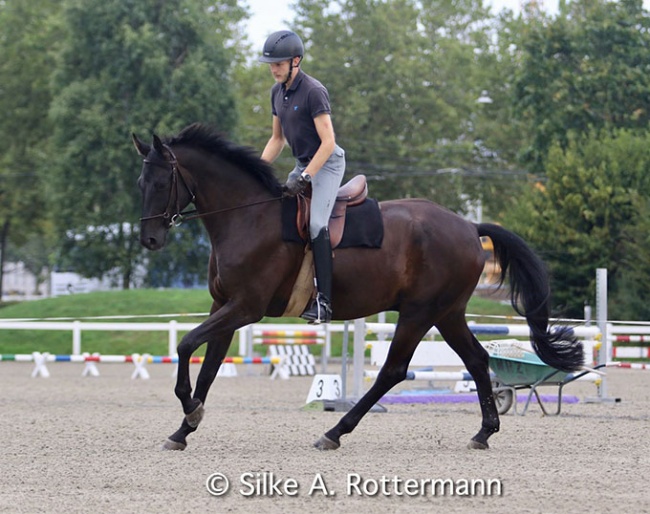
- By Max Jaquerod and Silke Rottermann
A bit more than three months have passed by until I last visited Max Jaquerod and his then newly acquired Swiss warmblood gelding Fantastico at the beginning of June 2023. The 6-year-old gelding by Frascino had spent the previous two years as an army horse and was chosen by Max as his future dressage horse after his mare had to retire due to an idiopathic string-halt.
Whereas the elegant Fantastico had enjoyed a versatile training at the army stables near Berne and profited from it in several ways, his more profound dressage training only just began when Max took him under his wings at the end of May 2023.
An avid advocate of classical dressage principles, the 28-year-old amateur took his new equine partner back to the basics in order to build a solid foundation for the black gelding’s future dressage career.
In September 2023 I met Fantastico now in his new home, the NPZ (National Horse Centre) in Berne (SUI), the former world famous cavalry stables, to keep hold of his progress with my camera for two days and to interview Max what has happened since my last visit.
Three Months On
As I already mentioned and explained in my first article about the training of Fantastico (or „Fanti“ as we usually call him) it was of paramount importance for me to establish diagonal and lateral aids with him before moving on.
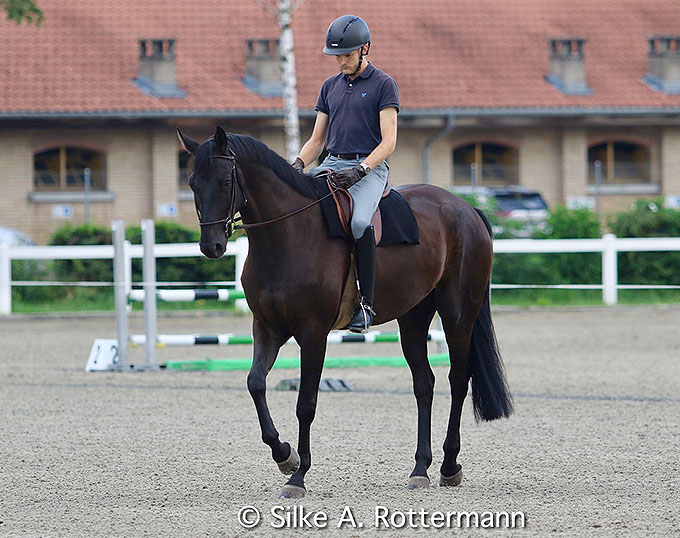
it is an essential which already a young horse has to learn.
It is inseparably connected to the poll being the highest point
The focus I had in our work over the summer months was to improve and maintain the self-carriage of Fanti, over all as he got used to having the tendency to lean on the bit and come too low. Now he should constantly remain with the poll the highest point and allow to be bent on both leads / reins. (In times where absolute elevation seems to enjoy a doubtful revival, I allow myself the remark that the poll the highest point does not mean a neck is elevated like the one of a Grand Prix horse; the poll the highest point isn’t relating to the length of the neck.)
For that goal to be achieved I work him with a lot of lead- and flexion changes, forward and lateral movements.
Of course here I talk about our dressage work, but actually this is only about 2/3rd of what Fantastico was doing every week. My girlfriend and I take great care he is having a life outside the arena. We hack him weekly, also over undulating terrain and my girlfriend takes great joy in jumping him on the cross country track we have at our door-step at the Swiss National Horse Centre.
Warming-Up on a Figure of 8
I still start warming up in walk the way I have described in part I of the series. When I start trotting, I warm Fantastico up on a big circle in a relaxed working trot with little contact. He is just supposed to go along the outside rein.
With time I make the circle smaller and change the lead regularly. That all sounds very simple, but it is not really because the young horse has to keep the track and isn’t allowed to lean on the bit during the transition from one circle to the other.
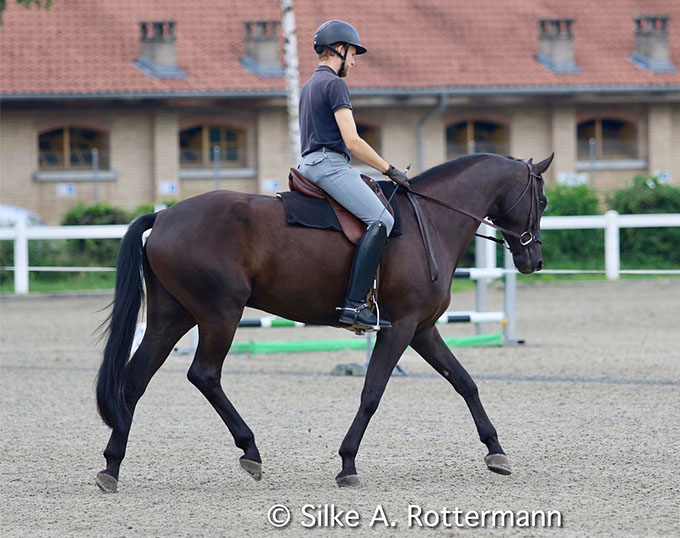
Fantastico tended to come a bit low in front which then
disturbed a 100% clear rhythm in trot. However,
he is going energetically forward here, looking for the
contact.
Very often riders make the mistake and push the horse too much to the outside with their inside leg and also have their own leg too far behind the girth.
It would be harmful with a horse like Fanti to do exactly this because that way you prevent the horse from bending to the inside leg. So instead I remain quite close to the girth with my leg and keep him in a shoulder-fore position. Then I achieve the bend I need to change the lead / rein and then the horse gets round and light to the inside rein.
If the horse is pushing to the inside of the circle it is wrong to try pushing with the inside rein over the withers to keep the horse outside. Because then I slow the horse down and prevent the horse to move forward freely. Instead the work has to be done with the rider’s inside leg. It remains at the girth and brings the horse back out to the circle -line so that I am able to limit the bend with the outside rein and remain light with the inside one.
Perfecting The Shoulder-In
The shoulder-in is an absolutely essential movement to train a horse and it is not for nothing that the famous French master de la Guérinière described it as the first and last thing to teach to a horse in his master-piece Ecole de Cavalerie.
What seems contradictory at first, is perfectly logical: You teach the shoulder-in quite early to a horse to get the benefit and you never stop perfecting this movement and thereby increasing its effects in the course of a horse’s training. One works on the bending of the horse in that movement in which the horse walks straight behind and crosses in front.
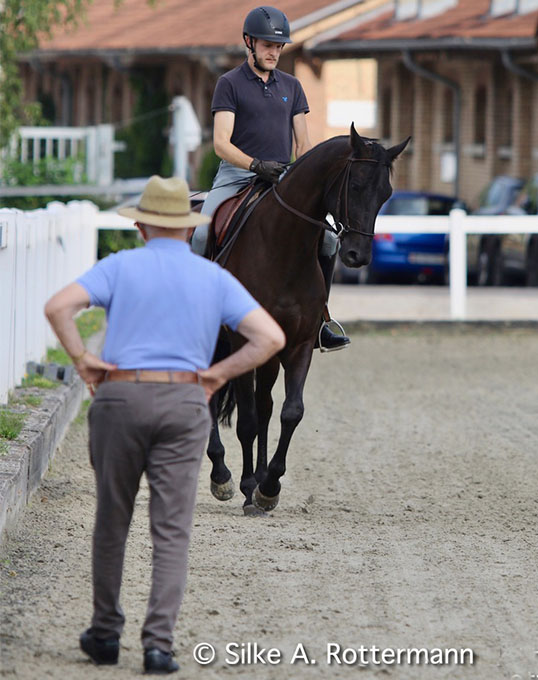
hand and legs in shoulder-in (here a bit
away from the fence) is a challenge
which
cannot be mastered in a few days or weeks
The young horse like him first has to understand that the forehand can move away from the first track to the inside without the horse beginning to sway. This is a challenge at first: I had to extremely focus to keep Fanti there with the outside rein and the inside leg. The outside rein initiates the angle, the inside takes care for a slight bend. At the beginning I asked very little: a low angle and little bend in order not to overtax my inexperienced horse. Before we start we have to be aware that a new exercise might bring a horse off balance at first and that this is not unusual, but natural. But it is our responsibility to never put our horse in a position in which it is impossible for him to regain a certain balance soon again.
It is very important to take care the horse accepts the aids without any tension. For that it is of absolutely paramount importance is that the rider sits balanced and applies 200% correct and clear aids. Perhaps nowhere else the famous „inside leg to outside rein“ rule applies more strictly than with shoulder-in. And whatever difficulties turn up in this movement, it is this rule which solves them, providing a forward and relaxed moving horse.
There is no other secret behind a horse learning successfully than having a calm demeanor, giving the correct aids and repeat an exercise often, but at the same time execute it a short and not a prolonged time. The legendary leader of the Spanish Riding School in Vienna, Colonel Alois Podhajsky put that essential principle in a nutshell when saying that the rider must first learn to control himself before he can control his horse.
The horse always takes his own time to understand and establish a new movement and it was no different with Fantastico.
But I was not only schooling him, he was also schooling me in learning to accept and to endure that something isn’t perfect over a longer period of time than I expected. You as a rider have to be patient and just make sure you apply the correct and clear aids to the horse.
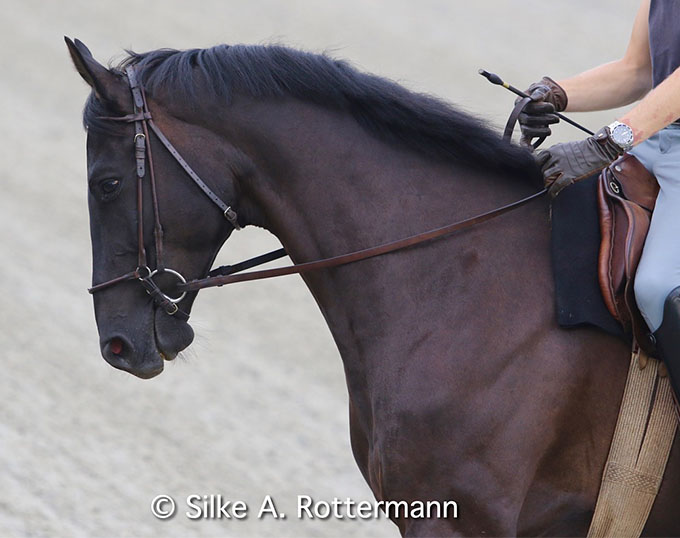
but do not misunderstand it with no connection.
Fantastisco is lightly connected here, but he could
be a touch more in front of the vertical to seek the contact
and then the poll would also truly be the highest point.
His tendency to hold back is still visible here
At the beginning Fantastico also often tilted his head to the right during shoulder-in and it was important not to try improving this at any cost during the movement itself. Because the crookedness was only the expression of a different problem, his lack of balance. So I asked less of an angle and took care he didn’t tense up und one day the problem solved itself: Now Fanti is very light at the inside rein, goes at the outside one and is tilting much less and only on occasions.
Transitions Between Shoulder-In and Half-Pass In Trot
Once the idea of shoulder-in was established, I started exercising first transitions to half-pass and back to shoulder-in. During this transition from shoulder - in to half-pass the horse has to remain in the shoulder-in-position, but the hind-legs have to transition from going forward to crossing. The forehand leads the direction which means that the shoulder first needs to leave the track and the croup follows.
As coordination is the challenge for the horse and once again, we cannot expect a perfect execution during the first time we practice this. The goal has to be to make the horse acquainted with the idea and the aids.
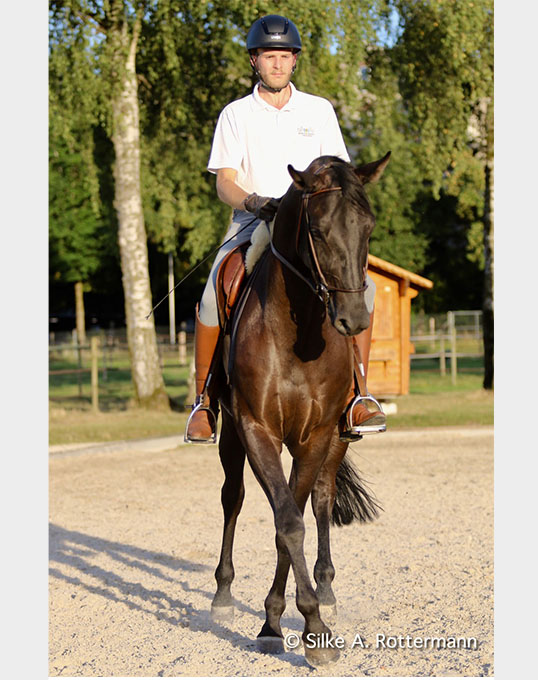
from the shoulder-in will not be perfect for a
longer time, but they give the horse the idea
about the aids and the coordination of
his body in this movement.
I still remember Fanti’s first attempt: He started to sway violently and the croup took the lead soon, so he lost the shoulder-in-position and I had to bring him back to shoulder-in after just two steps. But I repeated this exercise on a regular basis and just corrected Fanti by bringing him back to shoulder-in, get that bend again and start all over.
Soon it was not 1,2 steps, but 3 or 4 steps until the imbalance showed, then after a few months and without putting it as an aim Fantastico was able to half-pass over half a diagonal without being thrown off balance. Of course with such a young and inexperienced horse I do not ask a steep half-pass, I do not ask a pronounced bend or lots of collection—this will all come later on its own once the horse is more routined and stronger in his body.
I ride long and flat half-passes, for example from H to A or F to C. It goes without saying that the rider isn’t allowed trying to force something. To restore the balance in the shoulder-in-position is the way to correct any signs of imbalance and should be done as soon as the rider feels them. It is harmful if the horse shows signs of resistance, due to imbalance or whatever reason, to intensify the aids and press the horse on. To transition back from the half-pass to shoulder-in in the middle of the arena is also a good check how balanced the horse is without having the help of the fencing,
Tightening the Circle in Canter
Although Fantastico has a good quality canter it is here where it is the most difficult for him to remain light and carry himself. It is therefore lots of work to achieve this goal and I suppose I have to continue improving him in the regard perhaps all his life.
To improve his self-carriage in this gait the exercise of tightening the circle is beneficial.

to improve engagement and balance in this gait, if the
rider doesn’t fall in the trap of pushing and shoving or forcing
the horse on the bit.
But how to get there? Again we as riders aren’t allowed to give in the natural temptation to push the horse more with the legs when the circle gets smaller. In contrary, we have to remain relaxed and act with a minimum of aids, even if we feel we have to do the opposite. It is never about more or stronger aids, only about clear and clever ones.
Once Fantastico moves with the required self-carriage on the big circle line of about 20 meters I start diminishing the circumference. This tightening of the circle line requires more collection and shorter strides which both requires more of an effort of my horse. It is important that the rider doesn’t give in the temptation to preventively push the horse more and limit it with the hand. Instead I sit relaxed and attentive and only intervene only if Fanti tries to slow down a bit and tries getting heavier in front. Then I limit at the outside rein and give a short clear impulse with my inside leg. The slight opposing with the outside rein prevents him from coming deeper. This procedure takes its time, but in the end the horses really understand what is required and it truly improves the canter.
When practicing the tightening of the circle in a canter one has to be aware that canter is a dissymmetrical gait in which the young horse tends to put the croup inside and for that reason you put the horse in a slight shoulder-fore position. While cantering on a circle-line and by making the circle smaller, the horse naturally tends to deviate to the outside with his croup. For that reason this shoulder-fore position has to become a slight travers-like one in which the riders gets the feeling the croup of the horse gets slightly inside. This travers-like cantering keeps the horse on the circle line and this is an essential precondition to straighten the horse which is in turn necessary for collection.
Like with all exercises: Quality and not length is what counts. I always end this exercise by giving half halts to make sure the subsequent transition to walk is executed without the horse falling onto the forehand.
After many weeks of repetition and exercising this on a regular basis, Fanti now remains quite light on a small circle line of about 8 meters and activates his hind-legs which as a result have started to carry more.
Counter Canter
The balance problem in canter which Fantastico revealed in the first months of our partnership was also shown in the fact that he cantered a bit wide behind. So it was very important to canter him with longer reins forward in the arena and during hacks to let him find a natural balance and get confident in this gait.
My girlfriend Ivana takes great pleasure in schooling him over lower cross country fences which we have on the equestrian facility in Berne. Fanti absolutely loves this and it also helped with his balance in canter and with transitions within the gait when Ivana lengthened or shortened the strides before fences. He learnt to do it so beautifully that both won an entry cross-country competition at a national show home over fences he already knew from his training. Both had a blast and even won the class where the shown style was judged.
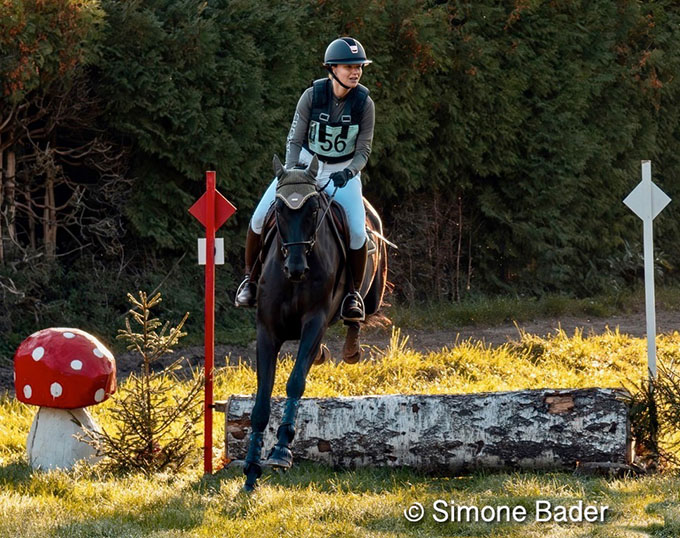
with his balance and confidence in canter.
In autumn he won an
entry class with Ivana Volken
in Berne.
The reason among others is that Fantastico reacts very sensitive to the slightest shift of weight. Not everybody might cherish such characteristic which requires a rider who acts very consciously. But we can turn this sensitivity into our advantage once we are aware of it and in control of our own body. So in this case I put more weight on the inside seat bone and made sure Fantastico doesn’t change the lead / rein on his own because as soon as I remained in a neutral position, he would change the lead / rein.
Thanks to this discovery I was able to start working on the counter canter which before seemed very tricky.
The main principle or idea behind keeping the counter canter is that the horse remains slightly in the position of the true canter. For example I canter on the left lead / rein, change lead / rein. My inside leg maintains the canter and I keep the shoulder left which maintains a slight shoulder-fore position of the counter canter. With a young horse the old outside leg can still be significantly behind the girth, although we have to take care not to push the croup to the outside. Also a slight flexion of the head to the outside is still allowed then. Once the horse has learnt to canter like this, it is hard for him to change the canter back to true canter.
Of course at the beginning I did not ride deep into the corners and it was more than enough to just ask for half a big circle in counter canter. The aids have to again be clear, simple and repetitive and it becomes obvious that the more the horse gets used to them and the new position, the more the rider can increase the duration of the counter canter without getting in danger of losing it.
Counter canter is an excellent exercise to collect the canter because the horse passes the corners in this slight shoulder-fore, but being straight in himself and this improves the balance and carrying power.
Single flying changes
Some may rightly say that to work on the counter canter and single flying changes at the same time is neither recommendable nor beneficial.
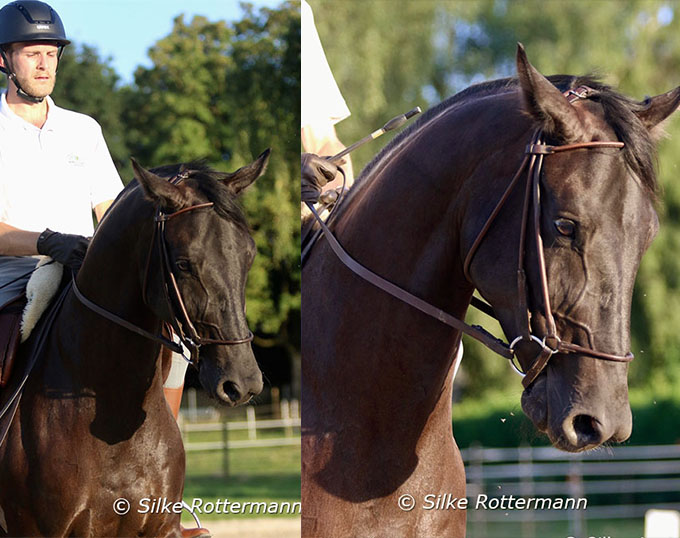
tilting of his head reveals he is not completely
balanced in this moment.
Right: A few moments later the 6-year-old has regained his
balance and is not tilted anymore
However, sometimes we have to make exceptions in the horse’s favour. In Fantastico’s case he did flying changes easily, but first struggled a bit with the counter canter. So my grandfather decided to make an exception and work on flying changes first, rightly assuming the counter canter would then be learnt via this route when. It is exemplary that despite all reasonable principles one also always has to look at each horse as an individual. When a horse offers something like Fanti does with the flying changes, we can take it, but in a responsible way. In hindsight his judgement was proven to be correct once again.
When I first sat on Fanti in May 2023 it soon become apparent to me that he changes canter easily if I shift my weight and according to the onlookers on that day he changed clear, forward and with real ease, and to me it felt quite balanced. So his single changes looked exactly like we want them in a trained horse, with the restriction that it was him who decided when to change and where.
It is nice to have a horse so talented for what was such a big challenge for my previous mare. But it is just another kind of challenge to cultivate that talent so that Fanti changes to my precise aids and at the place I want him to. So it was all about making him listen and making him wait until I allow him to execute a single flying change.
Flying changes truly seem to be a science in itself, but the principle is to bring the horse into the position of the new canter while still being in the old one and without the horse anticipating or getting tense.
What does it exactly mean ‚to change position‘? It means that I ride Fanti towards the new outside rein and leg and therefore bring him into a slight shoulder-fore position on the new lead / rein , but he only changes once my inside leg goes forward.
Sounds easy, is damn difficult! It is that difficult because many horses are not very comfortable with being put in the new position without promptly getting allowed to change the lead / rein.
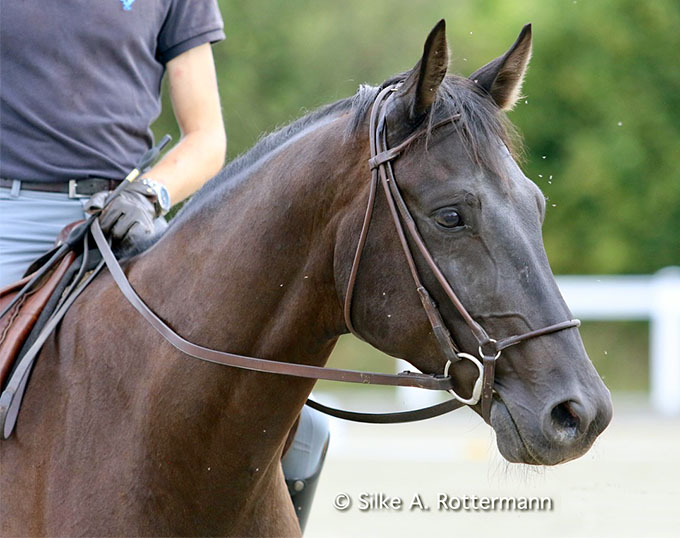
a big foamer, just gets slightly wet lips. Max has
changed from the Baucher snaffle to an eggbutt
as he felt it better suits his horse
Even with a relaxed horse who is listening horses like Fanti who have no problem to execute a single flying change might not wait long enough, but change on their own accord. It is very useful then to teach the horse first to really canter totally straight along the outside rein which means the horse canters without any flexion of the head and with forehand and hindquarters perfectly in tune. From this absolutely straight canter one can put the horse in a tiny half-pass which prevents them to change too early while changing into the new shoulder-fore position. Once the horse is put into the new position and would like to change leads / reins, this tiny half-pass movement is stopped by the new outside reins, the new inside leg only acts forward and the horse changes.
Put It to the Test
I neither ride nor train to compete. To fit in shows in the little spare time I have working full-time as a medical doctor is a challenge.
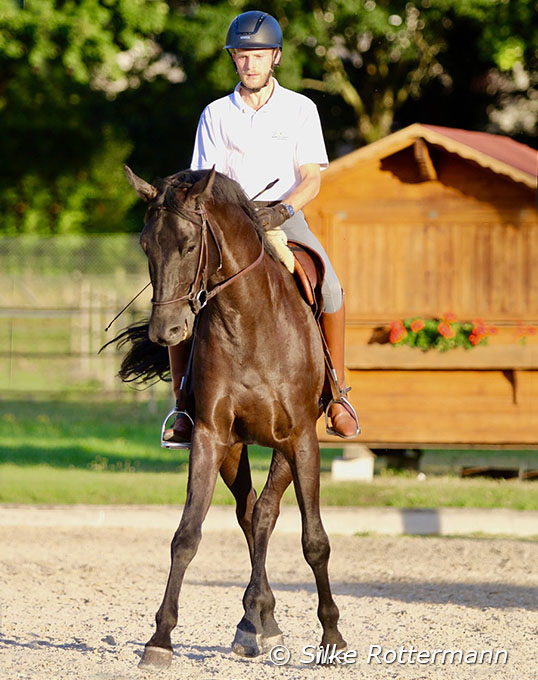
already showing a nice bend, but
he is a bit loosing his self-carriage and as
a result takes a stronger contact, crossing
his jaws
Because Fanti has shown he is pretty unperturbed by the typical show atmosphere when I tested him shortly after he arrived at his current stable in early summer of 2023, I decided to put in a few starts in novice classes over the late summer / early autumn.
To my utter delight he won both novices classes near Basle where he was outside the ‚comfort zone‘ of his home stables for the first time. His exceptional character and attitude enables me to ride him in foreign places like at home. He does not mind the other horses, the typical hustle bustle of small shows with kids screaming, dogs barking, other horses warming up right next to the arena in which he has to compete.
My horse just allowed me to focus on my job ahead and that is truly fantastic.
This was followed by a show again at his home stables in Berne and it was the annual army championships in which 38 members of the Swiss militia army contested. To my surprise and joy Fantastico did us very proud by winning.
So far the first months with Fantastico have been amazing and it is a real delight to work with this ever so willing horse and to form a better partnership day by day. He is not a born World champion regarding his movements, but he is always trying his hardest and this is the most wonderful characteristic in a horse because it suits the principle of classical dressage perfectly.
Part III coming soon...
By Max Jaquerod with Silke Rottermann - Photos by Silke Rottermann.
Related Link
Fanti's Progress - What Good Dressage Training Can Do to a Horse
More Training and Classical Dressage Articles on Eurodressage
Pierre-Eric Jaquerod: Dressage Now Needs to be a Spectacle Instead of a Presentation of Expert Knowledge
Pierre-Eric Jaquerod: "Swiss Dressage Has Not Woken Up in Time for Transition"
World Championships Berne 1966 Through The Eyes Of…
The History of the Shoulder-In
"Welcome to the Circus" - A New Series on Classical Dressage and the Circus